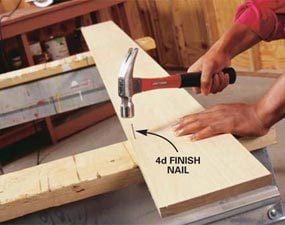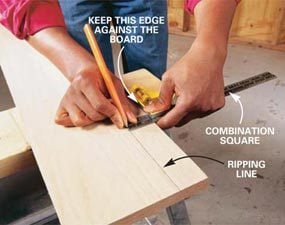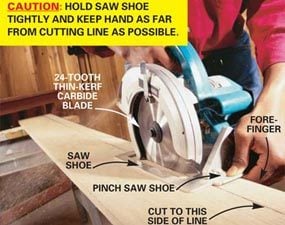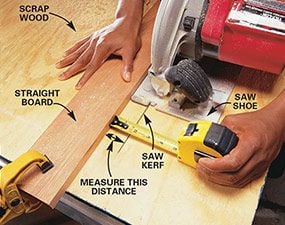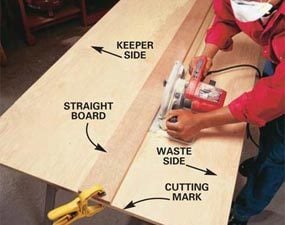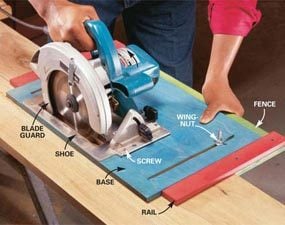How to Use a Circular Saw: Long Cuts
Updated: Oct. 09, 2023Learn how to safely saw boards freehand, cut plywood with a straightedge guide and build a ripping jig for accurate cutting with a circular saw
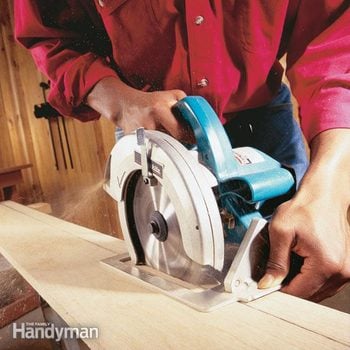
- Time
- Complexity
- Cost
- An hour or less
- Beginner
- Less than $20
Saw boards freehand
Even if your woodworking is limited to an occasional weekend project, you’ll eventually need to cut a narrow piece from a long board or sheet of plywood. Sawing long boards is easy if you own a table saw. But you can also do it accurately with a good circular saw. In fact, it’s usually easier to cut long pieces of plywood with a circular saw and a straightedge than to wrestle unwieldy sheets through a table saw. A circular saw won’t cut as smoothly as a table saw, but with a couple of techniques, a little finesse and some practice, you can cut almost as accurately. Sound farfetched? Not really—pros do it all the time. We’ll show you how to use a circular saw to quickly and accurately cut long boards and plywood, and give you plans for a handy cutting guide attachment for your saw.
Learn how to make perfectly straight cuts using a circular saw in our video tutorial.
Nail down the board and use your finger as a guide-carefully!
This is a quick way to cut a few 2- to 4-in. strips, but if you have to cut narrow strips often, build the jig shown on p. 32. For this method, you must nail the board directly to the sawhorses with finish nails (Photo 1). Use 4d finish nails for 3/4-in. thick wood and 8d finish nails for 1-1/2 in. boards. Then mark the board and cut it to width (Photos 2 and 3). This method results in a board of consistent width and parallel sides whether the board you’re cutting from is straight or crooked. If you want to create a straight edge on a crooked board, mark the board with a straightedge or chalk line instead.
Position your hand on the wide section of the saw shoe, not on the narrow side near the blade, and grip the shoe with your forefinger and thumb. Your forefinger acts as a guide. As you cut, direct pressure straight ahead through the handle of the saw, and concentrate on the line. If the saw starts to wander from the line, back up to about 6 in. behind where you first strayed from the line and start again. Before you squeeze the switch to restart the cut, make sure the saw blade is perfectly aligned in the kerf and maintain a firm grip in case the blade catches and jerks the saw. Good follow-through is the secret to an accurate finish. Guide the saw beyond the end of the board as if the line continued.
Caution!
Don’t use this method If the board is splintery or if your finger will be closer than 3 in. from the saw blade.
Cut plywood with a straightedge guide
Clamp a straightedge for super-straight cuts
Clamp a perfectly straight board or metal straightedge to a sheet of plywood to make cabinet-quality straight cuts. The key is to align the straightedge at exactly the right distance from the cutting line (Photo 2) and keep the saw shoe tight to the straightedge as you cut. Photo 1 shows how to make a test cut and measure the distance from the edge of the shoe to the edge of the blade. Measure carefully and record the dimension for reference. Then offset the straightedge from the cutting line by this distance (Photo 2).
When you begin a cut, barely nick the plywood with the blade to make sure the blade just touches the outside edge of the cutting mark. Move both ends of the straightedge slightly to adjust the cut if necessary, then reclamp it. At the beginning of the cut, press the front of the saw shoe against the straightedge. At the end of the cut, keep the back of the shoe tight until the cut is complete.
Tip:
Clamp the straightedge on the piece of plywood you’ll be keeping. This way, if the saw accidentally wanders from the straightedge, it won’t ruin the piece you’re keeping.
Building a Circular Saw Rip Guide
A jig for narrow strips
If you don’t own a table saw, you can build the guide shown in Fig. A and attach it to your circular saw. It helps you to cut narrow strips (1/2 in. to 6 in. wide) with near table-saw precision (Photo 1). You may have to modify it to fit your saw’s shoe. It takes about an hour to build this circular saw rip guide.
Cut the plywood base and pieces carefully to make sure they have parallel sides and square corners. Make the slots and the hole for the blade and blade guard by first drilling 3/8-in. holes in the corners and then cutting between them with a jigsaw. Set the base over the fence and align one long edge. Then snug the rails up to the sides of the base and screw them to the fence with 7/8-in. screws. The completed fence assembly should fit snugly and slide easily. Connect the fence to the base with carriage bolts and attach the saw shoe to the base with small screws. Drill 5/32-in. holes in your saw shoe and attach the guide with 5/8-in. screws.
Figure A: Jig for Narrow Strips
This guide allows you to cut narrow strips with your circular saw.
Safety First
Making long cuts can be dangerous. Before you try it, read the following safety precautions.
- Wear safety glasses and hearing protection and avoid loose-fitting clothes. Tie long hair back.
- Set the saw blade to cut about 1/4 in. deeper than the wood’s thickness.
- Secure boards less than 6 in. wide with nails and wider boards with clamps.
- Stand beside, never behind, the blade when you’re cutting. Keep bystanders away from the area behind the saw.
- Wedge the saw cut open with a shim if the board starts to pinch the blade and cause it to bind.
- Make sure the blade guard is operating freely. Never block or wedge it in the raised position.
Video: How to Cut Straight With a Circular Saw
Jeff Gorton, an editor for The Family Handyman, will show you how to make perfectly straight cuts using a circular saw. You will use this circular saw jig over and over again.
Required Tools for this Project
Have the necessary tools for this DIY project lined up before you start—you’ll save time and frustration.
- Circular saw
- Corded drill
- Drill bit set
- Hammer
- Jigsaw
- Safety glasses
- Sawhorses
- Tape measure
Required Materials for this Project
Avoid last-minute shopping trips by having all your materials ready ahead of time. Here’s a list.
- 1/2-in. plywood scraps
- 2 Wing nuts
- four 5/8-in. screws
- four 7/8-in. screws
- two 1/4-in. carriage bolts and washers
